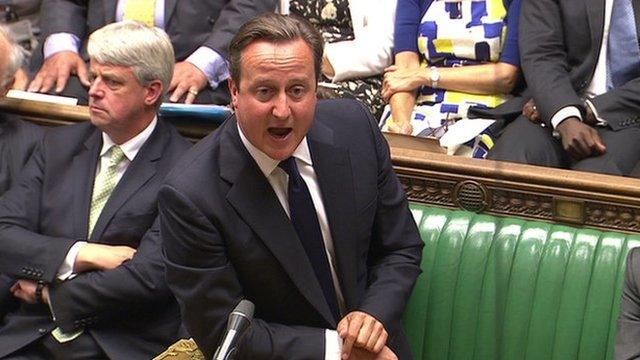School uniforms: A history of 'rebellion and conformity'
- Published

Many parents take photographs of their children at the start of a new term - but how did school uniforms evolve?
As the nation's children head back to school, proud parents have been excitedly photographing their offspring's posing in new uniforms. But they are far from the first to take pride in the school dress code. BBC News Online looks back at the history of the outfits kids up and down the land learn to love - or loathe.
Picture school uniforms from the past and the top hats and tails of Tom Brown's Schooldays or the cheeky cap-throwing of Just William may come to mind.
But in fact, according to historians, school uniforms began life not amid the traditions of the English public school but among charity schools

A blue coat, of the kind worn at Christ's Hospital, is thought to be one of the earliest examples of a school uniform
Schools such as Christ's Hospital, in Horsham, West Sussex, founded in 1552 in London, took up "fatherless children and other poor children" from the parish and educated them.
London citizens provided the children with clothes - notably a long blue coat - which led to the famous nickname for such institutions - "Bluecoat schools".
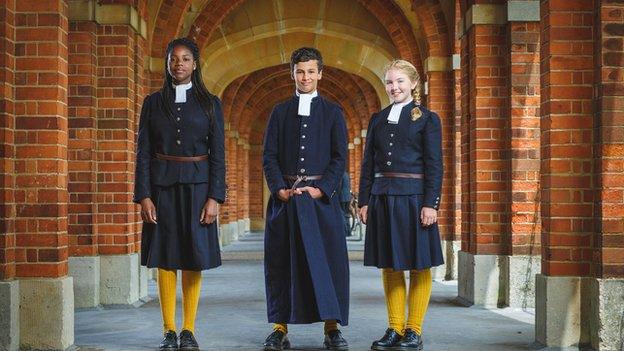
Today Christ's Hospital says its uniform is the oldest still in existence - and 95% of modern pupils support its continuance
Today the uniform continues to be worn by Christ's Hospital pupils - the school claims it is the oldest uniform still in existence.
And indeed, many older schools retain their traditional uniforms - from the straw hats of Harrow to the "Polly Bells" of Dame Allan's, a private school in Newcastle-upon-Tyne, which was founded as a charitable foundation in 1705.

The Queen met a Dame Allan's girl wearing a "Polly Bell" - the school's original uniform, now only worn on special occasions
Both are variants on the schools' original uniforms. While the Polly Bells are dusted off only for special occasions, Harrow tries to maintain its traditions around public-facing places of its site, such as its chapel.
"We relax the rules if the uniform becomes impractical - for example, on windy days, we don't want to see boys chasing their hats down the high street," said Jenny Simmons, the school's communications manager.
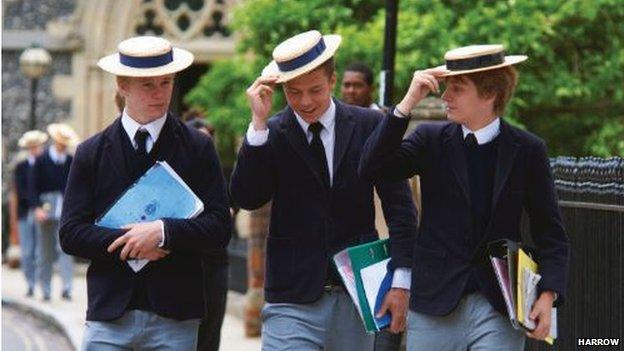
Harrovians still wear the school's famous straw hats
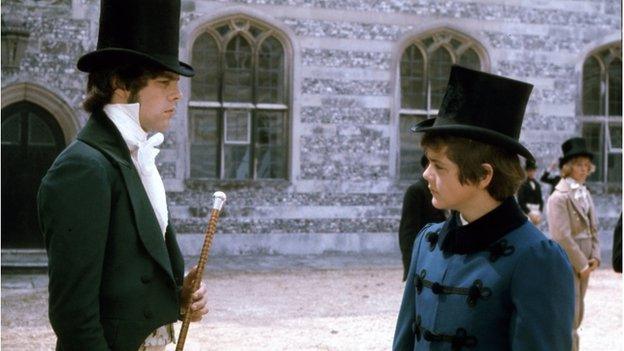
Tom Brown's Schooldays, set in Rugby School in Warwickshire, details one example of a public school uniform in the 19th Century
The records of The Ragged School Museum, in London, contain photographs of children wearing very individual uniforms at Hamlet of Radcliff School, a charity school founded in 1910.
"The boys are wearing Tam O' Shanters with pom poms, whereas the girls have starched aprons with gloves," said Erica Davies, the museum's director.
"I can't imagine anybody walking around Tower Hamlets wearing that - even in the 19th Century. You would learn to be tough, I suspect."
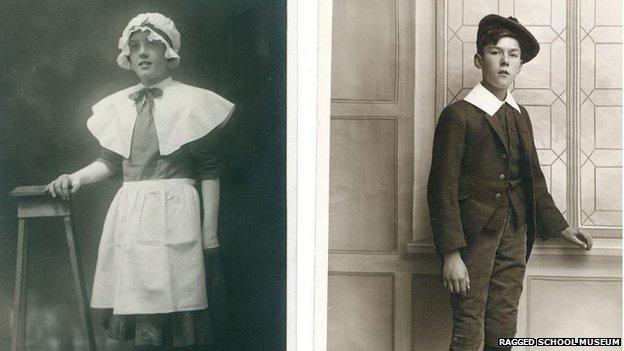
Children at Hamlet of Radcliff School in the 19th Century. Today the school says its uniform policy is "modern"
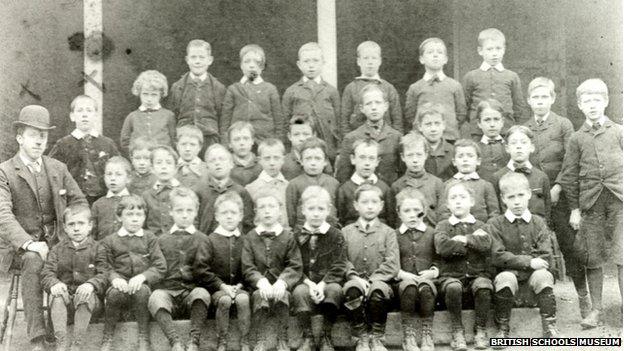
Children at charitable schools in the 19th Century often wore uniforms provided by the parish
Today the school is known as Stepney Greencoat Primary School, a state school, and it says its pupils wear a modern uniform.
Most schools have similarly evolved their styles, via the flat caps of the 1950s and the blazers and ties of the '80s and '90s, to the comfortable, practical style many adopt today.
A uniform list for Scorton Grammar School, in Preston, dating from the 1960s, now held by the British Schools Museum, has a list of requirements for pupils that include a cap, blazer and tie, a "reindeer green belted mackintosh" and dark grey flannel trousers - or shorts "until he has reached at least his 15th birthday".
It states: "At weekends and during holidays, it is left to the discretion of parents whether the uniform be worn or not, but it is particularly insisted the uniform should be worn in its entirety or not at all."
"Uniforms give schools a sense of identity and cohesion," said author and historian Alexander Davidson.
"When some aspects of society have become much less certain, uniforms suggest schools are there to provide certainty and order."
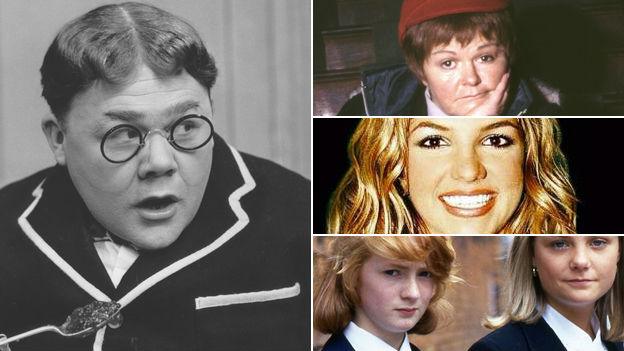
From Billy Bunter to Jimmy Krankie, via Britney Spears and Grange Hill, school uniforms have been used as symbols of rebellion and conformity
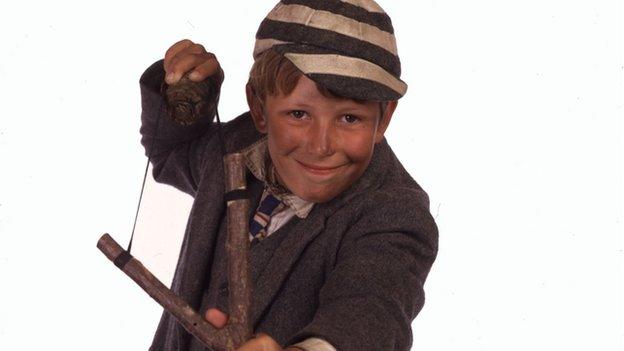
'Less' uniform means fewer opportunities for rebellion, like Just William, according to historian Alexander Davidson
However, school uniforms can be as much about rebellion as conformity, according to Mr Davidson.
"If children want to rebel, they can do it in the way they wear their school uniform," he said. "It's an expression of identity."
He believes there is "less" uniform in most schools than ever before - and with that, the opportunities for children to transgress the dress code have diminished.
"Little boys no longer have caps they can throw on the top of passing milk floats," he said.
In 2010, former Education Secretary Michael Gove tried to reverse this trend by backing schools who wanted to reinstate a blazer-and-tie uniform.
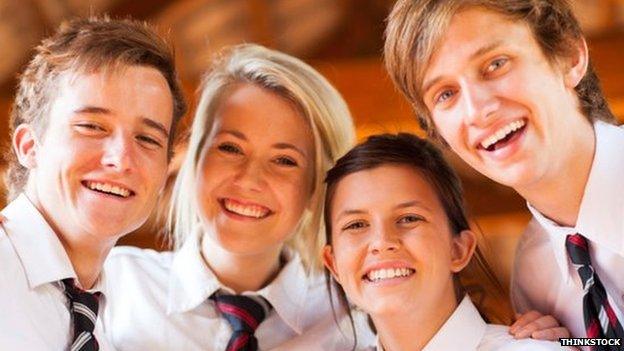
School uniforms can help integrate children from different economic backgrounds, according to Andy Gibbs from the British Schools Museum
But some schools now aim to create a uniform children - and parents - are happy with - a policy ministers say they want to encourage.
"There is an economic aspect to many schools' decision to adopt a uniform," said Andy Gibbs, curator and manager of the British Schools Museum.
"It brings equality to the clothes children wear in school, regardless of how wealthy their parents are. The widespread use of polo shirts as part of uniforms, for example, is a way of making them more affordable."
However, polo shirts are not for all pupils.

Pupils at Cottingham High School worked with a fashion designer to give a "professional work wear" look to their clothes
Cottingham High School, in East Yorkshire, has worked with fashion designer Lara Jensen to create a uniform that had pupil-appeal.
Jonathan Rogers, assistant head teacher, said pupils had felt a bit "embarrassed" by its previous uniform, which consisted of polo shirts and trainers and could look scruffy.
"When we consulted with our pupils, we found some of our fashion-conscious teenagers actually want to make a statement to the community," he said.
"In the end, we went for slim-fitting, stylish jackets and jumpers in a contemporary cut. I would describe it as quite professional work wear."
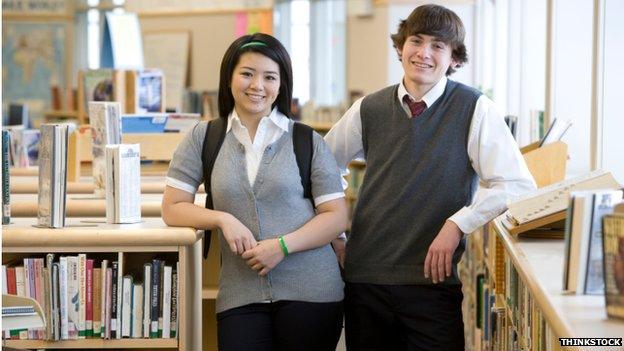
Today some schools say they consult pupils over their uniform policy
And whether the school attire is a fashion statement or a more relaxed affair, wearing a uniform seems surprisingly important to many pupils.
In 2011, Christ's Hospital surveyed its pupils to find out if it should keep its distinctive 16th Century style blue coats and yellow stockings.
About 95% said they should.
"It is important to stick to our historic traditions, not only to be unique and special, but it makes a sort of unity between us," said one.
"I personally feel proud walking around in my uniform, despite what people might say."
- Published15 September 2013

- Published4 September 2013
